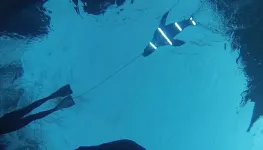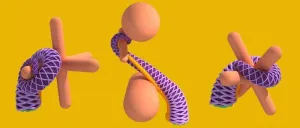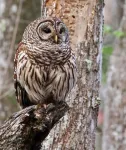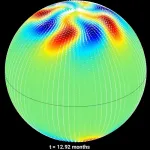(Press-News.org) How would you summarize your study for a lay audience?
T helper (TH) cells are essential immune cells that help other immune cells function effectively. When activated in response to environmental stimuli, these cells can differentiate into either TH1 cells, which fight against viruses and intracellular pathogens, or TH2 cells, which fight against extracellular pathogens like bacteria and parasites. However, scientists haven’t fully understood whether infected tissue itself has any role in directing the optimal T cell differentiation in response to tissue infection.
Our research has shown that virally infected neurons play a significant role by promoting the development of TH1 cells and inhibiting TH2 cells during viral infections. This communication between infected neurons and the immune system happens through molecules called neuropeptides, which interact with specific receptors on T cells to guide their fate. This process is crucial for the body to effectively control viral infections.
What knowledge gap does your study help to fill?
Our findings show that neuroimmune communication plays a crucial role in determining T cell fate, establishing a novel link between infected tissue (neurons) and the differentiation of T cell subsets.
What methods or approaches did you use?
Our team investigated the regulatory mechanisms that guide the optimal differentiation of T cells into specific lineages while inhibiting others. To do this, we used a technique called single-cell RNA sequencing (scRNA-seq) to study how genes are expressed over time, looking at two types of immune cells (TH1-TH2) in a cell culture system. We also applied CRISPR screening to identify which regulators help control T cell fate development into Th1 vs. Th2 cells.
By combining various gene and and cellular biology techniques, we demonstrated that the neuropeptide receptor RAMP3 plays a key role in how T cells develop using preclinical models.
What did you find?
We showed that neuroimmune circuits, influenced by neuropeptides and theirreceptors, play a pivotal role in determining T cell fate. We also explored how neuropeptides ensure optimal T cell differentiation and drive robust antiviral responses.
What are the implications?
Our study suggests that changes to neuroimmune circuits may help balance different types of T cell and lead to better immune responses. For example, previous research has shown an imbalance of TH2 differentiation over TH1 is correlated with increased death in patients with COVID-19. Targeting the neuroimmune pathways that regulate T cell fate decisions may offer new therapeutic opportunities for patients with severe COVID-19 infections, cancer and other autoimmune diseases.
Authorship: In addition to Kuchroo, Brigham and Women’s Hospital authors include Yu Hou, Linyu Sun, Martin W. LaFleur, Linglin Huang, Conner Lambden, Kimitoshi Kimura, Ruihan Tang, Jingwen Shi, Rocky Barilla, Syshwarya Subramanian, Antonia Wallrapp, Hee Sun Choi, Yoon-Chul Kye and Arlene H. Sharpe.
Paper cited: Hou Y and Sun L et al. “Neuropeptide signaling orchestrates T cell differentiation.” Nature DOI: 10.1038/s41586-024-08049-w
Funding: This work was supported by funds provided by the National Institutes of Health (U19AI133524, P01AI039671, P01AI056299, R01AI144166 and P01AI073748, R01AI168005 and R01DK127257) and the Klarman Cell Observatory at the Broad Institute.
Disclosures:
END
Research spotlight: Uncovering the mechanisms behind T cell differentiation
2024-11-11
ELSE PRESS RELEASES FROM THIS DATE:
Study reveals best timing for getting the RSV vaccine during pregnancy to protect newborns
2024-11-11
Current guidelines recommend that pregnant people receive a vaccine against respiratory syncytial virus (RSV)—which typically causes mild, cold-like symptoms in most adults but can be deadly for infants—during weeks 32–36 of pregnancy. New research led by investigators at Mass General Brigham suggests that vaccination earlier in that timeframe, closer to 32 weeks, could provide the best protection for newborns against RSV. The findings are published in the American Journal of Obstetrics & Gynecology.
“Receiving ...
Could lights stop shark attacks
2024-11-11
Surfers could be protected from future shark attacks following new discoveries about how to trick sharks’ visual systems made by Professor Nathan Hart, head of Macquarie University’s Neurobiology Lab, Dr Laura Ryan and colleagues.
Hart, Ryan and their co-authors of a new paper in Current Biology titled Counterillumination reduces bites by Great White Sharks say their work “may form the basis of new non-invasive shark deterrent technology to protect human life”.
These researchers previously discovered that great whites place a high reliance ...
Alarming increase in alcohol use during pandemic persists
2024-11-11
Embargoed for release until 5:00 p.m. ET on Monday 11 November 2024
@Annalsofim
Below please find summaries of new articles that will be published in the next issue of Annals of Internal Medicine. The summaries are not intended to substitute for the full articles as a source of information. This information is under strict embargo and by taking it into possession, media representatives are committing to the terms of the embargo not only on ...
Pandemic-era increase in alcohol use persists
2024-11-11
LOS ANGELES — Alcohol use increased during the COVID-19 pandemic and remained elevated even after the pandemic ended, according to a large nationally representative Keck Medicine of USC study published today in the Annals of Internal Medicine.
From pre-pandemic (2018) to the height of the pandemic (2020), heavy alcohol use among Americans rose by 20%, and any alcohol use rose by 4%. In 2022, the increases were sustained.
The rise in drinking was seen across all age groups, genders, race, ethnicities and regions of the country, except for Native Americans and Asian Americans. Adults ...
A new milestone in the study of octopus arms
2024-11-11
Mechanical engineering PhD candidate Arman Tekinalp, fellow graduate student Seung Hyun Kim, Professor Prashant Mehta, and Associate Professor Mattia Gazzola, all from the Department of Mechanical Science and Engineering at the University of Illinois Urbana-Champaign, recently published in the Proceedings of the National Academy of Science (PNAS). Their interdisciplinary collaboration also included Assistant Professor Noel Naughton (formerly a Beckman fellow) from the Department of Mechanical Engineering at Virginia Tech alongside researchers from the Department of Molecular and Integrative Physiology at Illinois ...
Fighting microplastics for a cleaner future
2024-11-11
Microplastics, plastics smaller than 5 millimeters, are littered across the world, contributing to global warming, disrupting food chains, and harming ecosystems with toxic chemicals. This is why Dr. Manish Shetty is working to break down plastics before they can get into the environment.
Creating sustainable chemicals and developing better waste management will contribute to better sustainability. This research is part of figuring out how to make green hydrogen available for waste management using catalysts.
Shetty’s research uses solvents in low amounts that also act as hydrogen sources to break down a specific class of plastics called ...
Tumor suppressor forms gel-like assemblies to sacrifice cancer cells
2024-11-11
(MEMPHIS, Tenn. – November 11, 2024) There are processes in the human body that can suppress the growth and proliferation of cancer cells. These mechanisms, including those involving the tumor suppressor protein p53, are widely studied due to their critical role in disease. Through studies of proteins that regulate p53, scientists at St. Jude Children’s Research Hospital have uncoupled a previously unrecognized tumor suppression mechanism. Usually found at low levels in cells, the p14 Alternative Reading Frame protein (p14ARF) is expressed at higher levels under oncogenic stress and activates ...
New research uncovers how Barred Owls interact with urban areas and why it matters
2024-11-11
Baton Rouge, November 4, 2024 – Novel research just published in the American Ornithological Society journal, Ornithological Applications, has revealed noteworthy insights into how Barred Owls (Strix varia) interact with urban environments, with implications for both wildlife conservation and urban planning. This study, conducted by a team of biologists from Louisiana State University and other institutions, highlights the connection between owl habitat selection and an urban landscape, underscoring the ...
50 years of survey data confirm African elephant decline
2024-11-11
Habitat loss and poaching have driven dramatic declines in African elephants, but it is challenging to measure their numbers and monitor changes across the entire continent. A new study has analyzed 53 years of population survey data and found large-scale declines in most populations of both species of African elephants.
From 1964-2016, forest elephant populations decreased on average by 90%, and savanna elephant populations fell on average by 70%. In combination, populations declined by 77% on average. The study compiled survey data from 475 sites in 37 countries, making it the most comprehensive assessment of African elephants to date.
Declines ...
Swirling polar vortices likely exist on the Sun, new research finds
2024-11-11
EMBARGOED: Until 3 p.m. ET on Monday, Nov. 11, 2024
Contacts:
Laura Snider, NSF NCAR and UCAR Manager of Science Communications
lsnider@ucar.edu
303-827-1502
David Hosansky, NSF NCAR and UCAR Manager of Media Relations
hosansky@ucar.edu
720-470-2073
Like the Earth, the Sun likely has swirling polar vortices, according to new research led by the U.S. National Science Foundation National Center for Atmospheric Research (NSF NCAR). But unlike on Earth, the formation and evolution of these vortices ...






